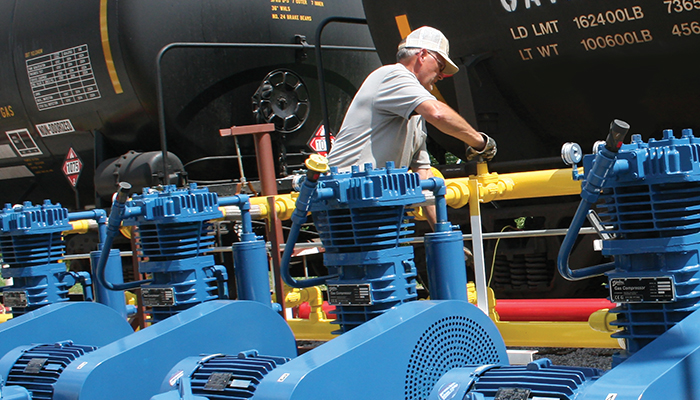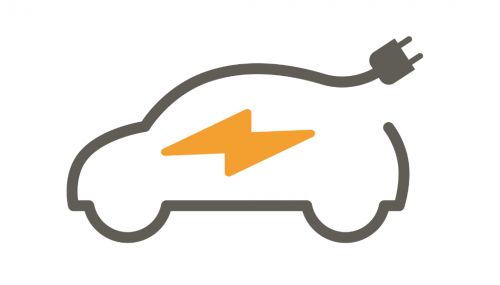All
A Faster Terminal Is a Better Terminal
by Thomas L. Stone, Blackmer

There’s no doubt that, as the years have passed and technology has advanced, our lives have sped up in so many areas. Cell phones and email have compressed communication intervals. The length of the current news cycle is now measured in minutes rather than days. Time-intensive tasks like grocery shopping or banking can now be completed in seconds with the help of the Internet and the tap of a few icons on a smartphone or the click of a few buttons on a computer keyboard.
In the world of petroleum-product delivery and supply, one area that was crying out for increased speed was the loading of LPG transports and bobtails. Long lines at LPG storage terminals have been a common sight for years as transport trucks queued up and waited…and waited…and waited to acquire their loads. This wait time is even more frustrating during those times of year when LPG demand is at its highest, such as the winter heating or crop-drying seasons in the Upper Midwestern United States.
Thankfully for all parties involved, some innovative thinking and the willingness to take a calculated risk have combined to create a new trend in LPG delivery and supply: ultra-high-speed loading of transports and bobtails. These impressive new transfer rates have been attained with the aid of highly reliable, effective and efficient sliding vane pump and reciprocating gas compressor technology.
The Need For Speed
When Altogas, an Alto, MI-based supplier of LPG, decided that it would move forward with its plans to build the new Red Arrow Transfer Terminal in Benton Harbor, MI, in recent years, General Manager David Hast tasked his Business Development Manager, Scott Tonkin, with the design of the facility. When Tonkin came back to him with his plans, Hast would have been excused if he had thought he had made the wrong choice. Why? Because Tonkin was proposing a 1,000-gallon-per-minute LPG throughput rate for the terminal.
“Scott immediately got the wheels spinning in his head and started talking about 1,000 gallons a minute and we said, ‘No, nobody’s done that and there’s got to be reasons,’” recalled Hast. “He also talked to several people we know and have worked with and they said, ‘No, you’re not going to do that, it’s not possible,’ but he’s a hard sell.”
One of those “other people” was Kevin Pruitt, Director of Integrated Systems for Gas Equipment Co., of Dallas, the distributor that supplies Altogas with its LPG-handling pumps and equipment.
“I received a phone call from Scott and he threw out a flow rate that scared the heck out of me—he wanted 1,000 gallons per minute,” marveled Pruitt. “My first reaction was, ‘Scott, I don’t want to promise you I can do that and under-deliver.’ He said, ‘Will you work with me to try to get there?’ and I said, ‘Absolutely, I would.’”
The number 1,000 was not one that Tonkin pulled out of thin air or decided upon because it was a nice, round figure. He performed the necessary due diligence, discovered the highest flow rate that was currently possible and put his faith in his ability to create a loading system that could push the upper limits of loading speed to four figures.
“We shopped for a number that a lot of people thought was a bit excessive for the gallons per minute,” admitted Tonkin, “but after talking to a lot of transport drivers, the fastest anybody could remember seeing was 850 gallons per minute, which is a fairly large number when it comes to loading an LPG transport, but why not do something different? That’s why we built it—to see what would happen.”
With the flow-rate goal defined, Tonkin set about finding the equipment that would make it possible. Driving the flow of LPG through the system piping from storage tank to transport would be the pumps and after consulting with Pruitt, Tonkin decided sliding vane pump technology would be the perfect choice for the operation.
“We looked at all kinds of pump curves out there and settled on Blackmer® sliding vane pumps for this application,” said Pruitt. “Blackmer’s always been reliable. We put Blackmer pumps in and don’t hear from the users for 10 years, and then they just might buy parts for the pump. They’ve just always been so reliable.”
“When I was talking with Gas Equipment Co. and other suppliers, they told me ‘Blue’ wouldn’t let me down, so that’s why we decided to go (with Blackmer),” confirmed Tonkin.
The Red Arrow operation requires four 4-inch sliding vane pumps and they are the perfect choice because they have been designed for maximum performance and reliability under the most demanding and severe service conditions. They feature a cavitation-suppression liner that reduces noise, vibration and wear, as well as replaceable casing liners and discs that allow for easy rebuilding of the pumping chamber to like-new condition.
But the proof would be in the pudding, and just imagine the looks of incredulity on everyone’s faces when those pumps were fired up for the first time and that supposedly unattainable 1,000-gpm flow rate was achieved.
“I’ve always liked to do things that sometimes other people haven’t tried yet,” said Bernie Vanderboegh, President of Altogas. “I didn’t think we could do 1,000 gpm either, so I remember when they first cranked it up the surprise from everyone, the adjectives when those meters were reading 1,000 gallons per minute; that was quite a pleasant experience.”
Moving at Warp Speed
If pursuing a 1,000-gpm LPG flow rate was jaw-dropping, imagine the looks of shock that must have greeted brothers Jim, Pat and Carl Wenner when they announced—in 2009, during the height of a stubborn economic recession—that they would proceed with plans to build a new LPG storage terminal near Cold Spring, MN, just up the road from the town where the Wenner family has operated numerous businesses since the 1880s.
“I thought it was a pipe dream,” recalled Jeff Munzel, Vice President of LPG & NH3 Supply, Inc., a Buffalo, MN, USA-based supplier of equipment and service for Minnesota’s LPG marketers.
The Wenners’ audacity was driven by the fact that rail service would be ceasing to Cold Spring, where the company had an existing LPG storage facility, so they bought a plot of land to the northeast of Cold Spring along Route 23 and filled it with five railcar-unloading platforms and 300,000 gallons worth of LPG storage capacity. The facility was an immediate hit, but went to the next level in 2014 when Kinder Morgan Pipeline Energy Partners L.P., completed the reversal of the Cochin pipeline, meaning that LPG would no longer be shipped into the state from Alberta, Canada.
Sensing an opportunity to fill the new LPG-supply void, the Wenners contracted with Reggie Fraley of Alpha Development & Construction LLC, Cold Spring, MN, and partnered with CHS, Inc., Inver Grove Heights, MN, the nation’s largest farmer-owned cooperative and the fifth-largest retailer of propane in the United States, on an expansion of the facility, which now has 10 rail-loading towers and 620,000 gallons of propane storage space.
“With the pipeline going down, it was a big leap for us to go from being a backup standby terminal to one that is the main choice in the area, but we knew that rail would have to play a bigger role in the state’s propane-supply chain and the opportunity was too good to pass up,” said Pat Wenner.
On the rail-unloading end of the operation, the facility, which has been renamed the Rockville Propane Terminal, is outfitted with 10 Blackmer reciprocating gas compressors that have the unique ability to perform both liquid transfer and vapor recovery. They feature ductile-iron construction that makes them stronger and more resistant to thermal shock and corrosion than cast iron, and leak-free operation that is ensured by the presence of O-rings, instead of gaskets, on all of the pressure-containing parts.
For the transport and bobtail loading operations, the LPG islands are outfitted with Blackmer 4-inch sliding vane pumps that have been designed for maximum performance and reliability under the most severe operating conditions. Standard features include cavitation suppression liners that reduce noise, vibration and wear; replaceable casing liners and end discs; ductile-iron construction with internal relief valves; self-priming and dry-run capabilities; and vanes that can be replaced without removing the pump from the piping system, which eliminates maintenance concerns and costly downtime.
“We took what was existing at the Wenner terminal and basically doubled it—storage capacity, unloading capacity, number of towers and put in a second loading island,” said Scott McClelland, Engineer at LPG and NH3 Supply.
Most importantly, the pumps and compressors have been able to keep up with the loading and unloading rates that are required—and have not flinched even on those busy days when more than one million gallons of LPG have made their way through the terminal.
“With the 10 Blackmer compressors, we can unload 15 railcars every six or seven hours, and with the four Blackmer loading pumps, we can do two transports every 15 to 20 minutes,” said Wenner. “We have done as many as 30 to 40 cars per day into the terminal, up to one million gallons into the terminal, and we can do even more. The terminal can move 100 million gallons a year, if we get to the point where we need to move that much volume.”
Thomas L. Stone is the Director of Marketing for Blackmer® and PSG®. He can be reached at tom.stone@psgdover.com. For more information on the full lines of innovative and high-quality Blackmer rotary vane and centrifugal pump and reciprocating compressor technologies, please visit www.blackmer.com or call (616) 241-1611.
Related Posts
 U.S. Competing to Secure Critical Minerals
U.S. Competing to Secure Critical Minerals
Posted on June 16, 2025
 The Clean Air Act, the EPA, and State Regulations
The Clean Air Act, the EPA, and State Regulations
Posted on May 14, 2025
 Day Tanks Support Back-up Generators in Extreme Conditions
Day Tanks Support Back-up Generators in Extreme Conditions
Posted on March 10, 2025
 Major Breakthrough in Lithium-Ion Batteries
Major Breakthrough in Lithium-Ion Batteries
Posted on February 12, 2025
Enter your email to receive important news and article updates.
